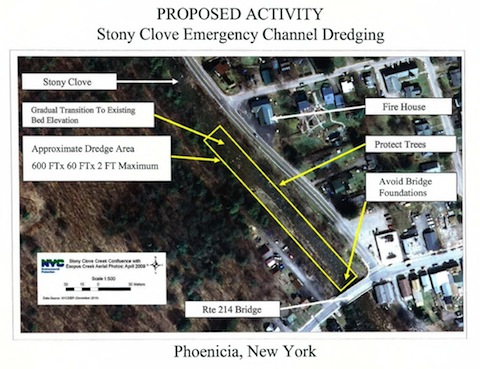After enduring two floods in two months last year, the residents of the Ulster County village of Phoenicia wanted to do something -- anything -- to fix their chronic flooding problem. Days after the December 1st flood, town and county officials rallied around a solution: dredging Stony Clove Creek.
The Stony Clove runs under a bridge on Main Street Phoenicia and, during the fall's floods, flowed up over the bridge and onto Main Street. After some contentious back-and-forth with Shandaken officials, the New York State Department of Environmental Conservation finally gave the town a permit for the dredging project yesterday. According to Shandaken Town Supervisor Robert Stanley, the removal of 2,700 cubic yards of gravel from 600 yards of stream could begin as early as May and as late as August.
"We argued for it as a temporary solution," Stanley says of the dredging. "We were trying to find an immediate fix to increase the volume of water flowing under the bridge."
But according to stream experts, including Jim MacBroom, a consultant who drafted Shandaken's dredging plan, dredging might fix flooding problems in the short-term, but in the long term might actually make them worse.
"We think that it's sometimes an emergency response to give short-term relief, but in the long run, it's definitely detrimental," MacBroom told the Watershed Post at the Ashokan Watershed Conference, which was held last Saturday in Phoenicia.
Dredging can be problematic for two reasons, MacBroom explained. First, because dredging disturbs a stream's natural equilibrium, it's almost always temporary.
"On a temporary basis, you may increase the size of the channel, but chances are it's going to fill back in again," he said.
Secondly, dredging can cause erosion upstream and can undermine a river's banks.
"Over time, as water comes over the lip of where you've done the dredging, it actually causes erosion to migrate upstream," he said. (See the video clip above to hear MacBroom's comments on dredging in full.)
The DEC, too, knows that dredging is, at best, good for preventing only a few floods. At the conference, Brian Drumm, an official at the DEC's New Paltz office, said of dredging, "We're stuck in a mode of putting a band-aid here, putting a band-aid there." DEC officials told the Times Herald-Record yesterday that the Phoenicia dredging project will not be a long-term solution.

Town and DEC officials say that this band-aid for Shandaken will not cause harm down the line. The town's proposal has been revised and spot-checked to make sure it does no harm, Stanley says.
"We’ve had these discussions in our meetings when we were trying to draw up the permit application," he said. "[The worry is that] by dredging the stream, it will create other natural spots where it will erode and deposit sediments in other spots ... In Phoenicia, there is no possibility of that happening. There's no other place for the stream to go."
Now that they have the permit and some grant money from the Ashokan Watershed Stream Management Program, Shandaken officials are also considering changing the shape of the bridge's wing walls and abutments to reduce turbulence and erosion taking place under the bridge. But that solution needs further study.
Dredging may not work in the long term to stop flooding, but it does have one thing going for it: it's something to do when everyone wants something done, fast.
During a visit to Phoenicia in December, Ulster County executive Mike Hein attempted to console distraught residents and business owners with promises of immediate dredging action:
"I'd like to see dredging this winter," Hein said in a speech on Main Street. "If it's not frozen solid in there, I want to be in there with machinery ... We're going to fight to get in there, we're going to fight to dredge, we're going to clean this out, because it's the only way that has been presented to me to provide any relief to this community."
Graydon Dutcher, who works for the Delaware County Soil and Water Conservation District, has seen this all before. In 2006, the Delaware County town of Walton experienced the worst flooding in its history. Houses and businesses were damaged and destroyed. At Saturday's Watershed Conference, Dutcher told the audience that Walton officials responded by catching dredging fever.
"Right after a flood, everybody wants to get right in a stream," Dutcher said. "You could've done more damage than good ... if you just go in there and bulldoze."
But that's what officials did to Walton's Third Brook, which had flooded out many of the houses along its drastically-eroded banks, Dutcher said.
"They took a bulldozer from one end of Third Brook to the other," Dutcher said. Gesturing towards a photo of the brook after the bulldozing, he pointed out that the erosion along the brook was even worse than before:
"See all those loose rocks? They're ready to go downstream during the next storm."
For more information on Phoenicia's dredging project, see the documents below.
Revised dredging proposal:DEC Flood Miti Project Descr.
Shandaken's initial Flood Report proposal:Flood Report 12-27-10












